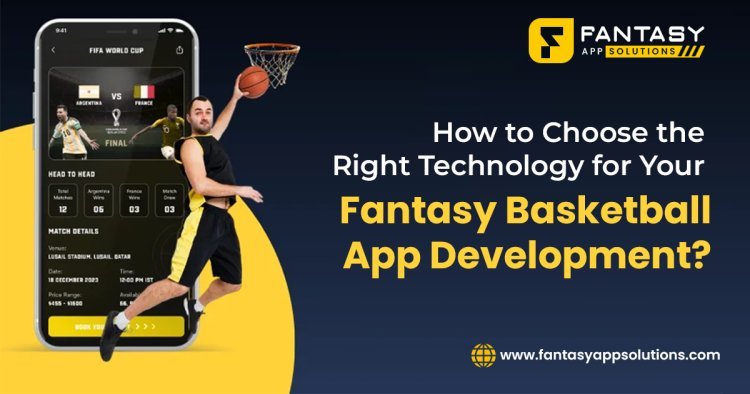How to Choose the Right Technology for Your Fantasy Basketball App Development?

The rise of mobile apps has revolutionized the way people engage with sports, and fantasy basketball is no exception. Whether you’re a seasoned developer or someone looking to bring your fantasy basketball app idea to life, choosing the right technology stack is crucial to ensure your app is scalable, efficient, and provides an engaging user experience.
The technology stack you choose can impact everything from the app’s performance to how it integrates with various services, so it’s essential to make the right decision. In this blog, we’ll dive into how to choose the right technology for your fantasy basketball app development, and why partnering with an experienced Fantasy Basketball App Development Company can make all the difference.
1. Understand the Core Features of Your Fantasy Basketball App
Before deciding on the technology stack, you need to clearly define the features and functionality of your app. Fantasy basketball apps typically include the following core elements:
- User Registration and Profiles: Allowing users to sign up, create profiles, and manage their fantasy teams.
- Real-time Data: Providing live scores, player stats, and performance updates from actual NBA games.
- Team Management: Enabling users to draft players, trade, and manage their teams.
- Leaderboards and Scoring System: Displaying the performance of fantasy teams and individual players.
- Social Integration: Allowing users to connect with friends, join leagues, and share updates.
The technology stack you choose must support these features seamlessly. Let’s break down the key technologies and considerations that will help you build a robust fantasy basketball app.
2. Choose the Right Mobile App Development Platform
The next decision involves selecting the right platform for your app. Whether you’re building for iOS, Android, or both, your choice of platform will impact the development process, as well as the technology stack.
Native vs. Cross-Platform Development
- Native Development: If you want to provide the best possible performance and experience on a specific platform (iOS or Android), you may choose native development. This involves using Swift for iOS or Kotlin/Java for Android. Native apps typically deliver the best performance and use the full potential of the device’s hardware.
- Cross-Platform Development: If you want to target both iOS and Android users simultaneously and save on development time and cost, cross-platform development frameworks like React Native, Flutter, or Xamarin are great options. These frameworks allow you to write the code once and deploy it across both platforms, which is ideal for getting your app to market quickly.
3. Backend Technologies for Handling Real-Time Data
In fantasy basketball, the ability to access real-time data is crucial. Whether it’s updating player stats, team performance, or live scores, the backend of your app must be capable of handling high-volume, real-time data efficiently.
- Node.js: If you need to manage a large number of users and real-time data efficiently, Node.js is an excellent choice. Its non-blocking architecture allows for scalable, real-time communication, making it ideal for apps that need to update data quickly and constantly.
- Python (Django/Flask): Python is another popular backend choice for building web APIs. It’s easy to scale and maintain, especially with frameworks like Django or Flask. If your app requires machine learning capabilities, such as predicting player performance or analyzing user behavior, Python’s rich ecosystem of libraries will be a valuable asset.
- Ruby on Rails: If you're looking for a development framework that allows rapid prototyping and a developer-friendly experience, Ruby on Rails might be the way to go. It's widely used for web applications and APIs, and its convention-over-configuration approach helps streamline the development process.
4. Database Selection
Choosing the right database is essential for storing and retrieving user data, player stats, and team details efficiently. There are two types of databases you’ll typically choose between: SQL and NoSQL.
- SQL Databases (MySQL/PostgreSQL): If your fantasy basketball app has structured data and requires complex queries and relationships (e.g., user profiles, teams, stats), an SQL database such as MySQL or PostgreSQL would be a solid choice. These databases excel at handling relationships between data tables and offer strong consistency guarantees.
- NoSQL Databases (MongoDB): If you’re dealing with large volumes of unstructured or semi-structured data, a NoSQL database like MongoDB may be more appropriate. NoSQL databases are designed for flexibility and scalability, which makes them a good option if your app requires rapid growth or more complex data structures.
5. APIs for Real-Time Data Integration
Integrating real-time sports data is at the heart of any fantasy basketball app. You'll need to rely on third-party APIs to fetch player stats, scores, and other real-time updates. Some popular sports data APIs include:
- SportRadar: Provides comprehensive sports data, including player stats, live scores, and more.
- Yahoo Fantasy Sports API: A great option if you want to leverage Yahoo's fantasy sports platform for your app.
- ESPN API: Another widely-used API that provides real-time stats, scores, and player data.
6. Security Considerations
With sensitive user data, including personal information and payment details, security is paramount. Implementing proper security measures will ensure that your app is safe from potential threats. Some key security practices to follow include:
- OAuth or JWT for secure user authentication.
- SSL/TLS encryption to protect data transmission.
- Regular security audits to identify vulnerabilities.
7. Scalability and Cloud Infrastructure
As your fantasy basketball app grows, you’ll need a reliable infrastructure to support more users and data. Cloud platforms like AWS, Google Cloud, or Microsoft Azure offer the scalability and reliability you need to grow without worrying about server management. Cloud platforms also provide services like content delivery networks (CDNs), databases, and storage solutions to ensure your app runs smoothly as user traffic increases.
Conclusion:
Building a successful fantasy basketball app involves more than just picking a technology stack—it requires careful planning, market understanding, and integration of real-time data. Whether you’re focusing on a seamless user interface, smooth backend development, or real-time data updates, working with an experienced Fantasy Basketball App Development Company can streamline the entire development process.
By leveraging their expertise, you can ensure that your app is built with the right technology, is scalable, and offers a top-tier user experience. So, if you're ready to take your fantasy basketball app idea to the next level, partnering with the right experts can make all the difference.
What's Your Reaction?












